'Teens, Social Media & Technology 2018' which the young people investigated in detail about the impression and utilization rate of social media

by Elijah O'Donell
Pew Research Institute of the think tank announced " Teens, Social Media & Technology 2018 " by thoroughly investigating how teenagers interact with social media and technology. According to the survey, three platforms that are particularly popular among teenagers are YouTube, Instagram, Snapchat, the percentage of young people who own smartphones is 95%, 45% young people almost always access online It is said that it is possible situation.
Teens, Social Media & Technology 2018 | Pew Research Center
http://www.pewinternet.org/2018/05/31/teens-social-media-technology-2018/
"Teens, Social Media & Technology 2018" by Pew Research Laboratories consisted of 1,058 young people living in the United States from 13 to 17 years of age living in the United States from 7th March to 10th April 2018 and their parents It is an analysis of an interview survey conducted on 743 people and summarized it.
According to the latest survey by Pew Research Institute, Facebook is proud of the huge popularity among young people in the US until recently, the most used "among" young people living in the United States from 13 to 17 years old It seems to be on YouTube. The graphs below listen to "Online Platform Used Everyday" on the left and "Online Platforms Most Frequently Used" on the right. The utilization rate exceeding 50% is four, YouTube (85%), Instagram (72%), Snapchat (69%), Facebook (51%), the popular in Japan is Twitter of the American youth In case, you can see that only 1 person in 3 people is used.
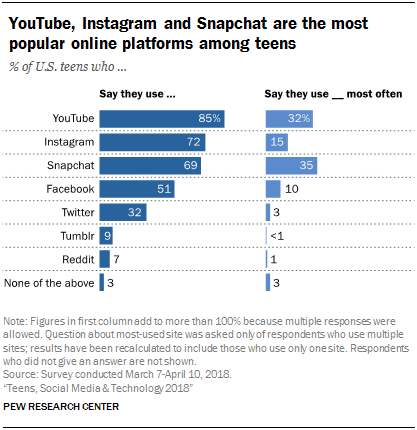
The most frequently used online platforms are sparse, but Snapchat (35%), YouTube (32%), Instagram (15%) are popular in that order.
Also, there is data that young people raised in families with low household incomes preferred Facebook more than young people raised in high-income households. The graph below shows the proportion of Facebook users by household income, 70% of young people who grew up at home with household incomes below 30,000 dollars (about 3.3 million yen) are using Facebook, whereas 3 It is clear that Facebook usage rate will decline as household income increases, 56% in homes of more than $ 100,000 to less than $ 75,000 (about 8.3 million yen) and 36% in homes with more than $ 75,000 It is getting.
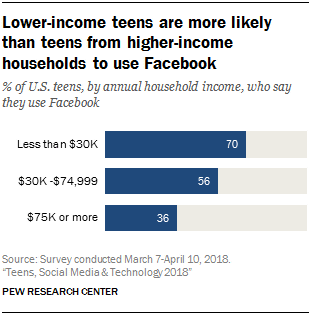
Compared with past survey data , it is clear that the usage pattern of social media is changing among teenagers, but this is only an example of how technology evolved, Pew Research Institute He wrote. What is noteworthy about such changes is that "smartphones are becoming ubiquitous to teenagers".
About 95% of the surveyed young people are in a state where they can own or use smartphones. By gender we say that 93% of boys and 97% of girls are accessible to smartphones. In terms of people, 94% for Caucasians, 94% for Negroes and 95% in Hispanics, the difference by race is almost zero, and even by looking at by household income and by parents' educational backgrounds, "Owning a smartphone or There is no big change in the percentage that it is available ".
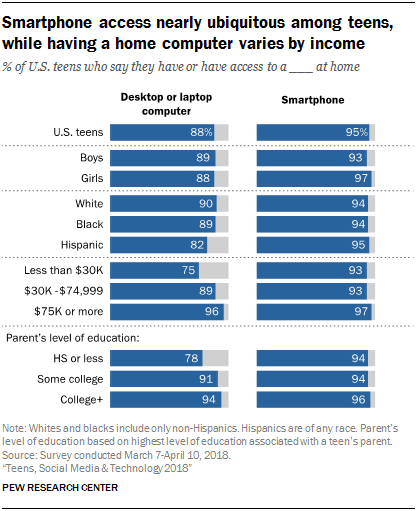
In addition, it is the graph below that investigated how often young people can access online. It shows that dark blue is "nearly always", blue is "several times a day", light blue is "low frequency" online access. In the data of 2014 - 2015, 24% answered that it was almost always accessible online, but increased to 45% in 2018, and the online access environment of young people is steadily being established I can tell you.
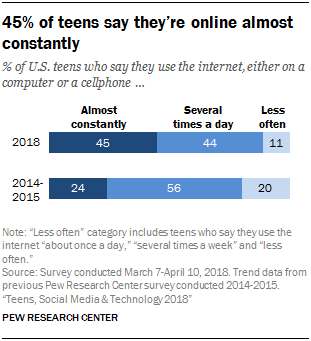
Furthermore, when I asked about the influence of social media on young people, 31% said they had a positive influence, 24% said that they had a negative effect, and 45 said they could not say either It got the result%.
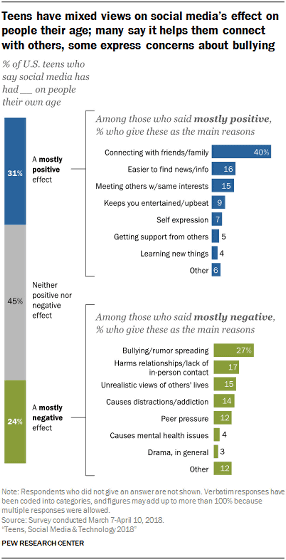
What I cited as a positive influence is "to get connected with friends and family (31%)", followed by "easily obtain news and information (16%)" "people with the same hobby (5%) "" I can learn about new things (4%) "" Others (15%) "" I feel happy (9%) "," self expression (7% (6%) "has become.
As a positive opinion, a 14-year-old girl's "Social media can talk with families in distant places, so I think there is a positive effect" and a 15-year-old boy's " , You can also make new friends "and so on. A 15-year-old girl said, "We can easily connect with people in different places and save social media through social media, sometimes asking for help," says social media You can see that there are not a few people who feel.
The negative influences on the other side were "diffusion of bullying and rumors (27%)" "harming human relations, lack of dialogue with people (17%)" "unrealistic view from others (15%) "," causing depression and poisoning (14%) "" pressure from fellows (12%) "" cause mental health problems (4%) "" exaggerate (3%) " (12%) ".
As an opinion that social media has a negative influence, 17 years old juvenile "negatively influence social human interaction", a 15-year-old boy said "say anything you want anonymously For example, a negative influence comes out ", a 15-year-old girl said," If someone provides a fake image in life, the one who saw it may feel that their life is not perfect " And so on are raised.
Furthermore, about whether young people have gaming machines at home. 92% of boys possess gaming machines in their homes, and in girls the proportion falls to 75%. And the percentage of playing games in some form is 97% for boys and 83% for girls, and you can read the tendency of both men and women to enjoy games widely.
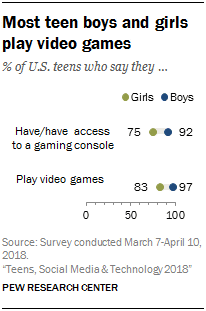
Regarding the possession rate of game machines, it is said that Hispanic young people 's ownership of game machines is rising compared to the survey of 2014 - 2015.
Related Posts:
in Note, Posted by logu_ii







